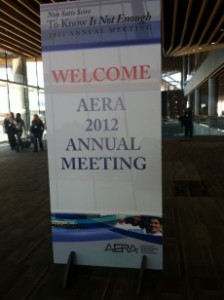 Two weeks ago, I had the exciting opportunity to go to the AERA (American Educational Research Association) Annual Meeting for the first time! For those of us in educational research, there is probably not a larger or more comprehensive event for researchers to come together and share their work. And from my fellow graduate students to faculty members and company executives, the atmosphere was definitely one of enthusiasm and passion for promoting excellence in education through research.
Two weeks ago, I had the exciting opportunity to go to the AERA (American Educational Research Association) Annual Meeting for the first time! For those of us in educational research, there is probably not a larger or more comprehensive event for researchers to come together and share their work. And from my fellow graduate students to faculty members and company executives, the atmosphere was definitely one of enthusiasm and passion for promoting excellence in education through research.
Vancouver, British Columbia was taken over by nearly 20,000 conference attendees this year – though it’s fair to say that local Canucks fans did a good job of making themselves known amongst the visitors as they cheered on their hockey team in the Stanley Cup playoffs throughout the weekend. The beautiful city on the water with its backdrop of snowy mountains, and cosmopolitan global culture offered a wonderful meeting place – and uncharacteristic amount of sunshine – for those of us in attendance. It would be virtually impossible to speak to the happenings of the entire conference – the AERA program was a lot like the local yellow pages, full of over 400 pages of offerings over the 4-day event. (Thank goodness for the mobile phone app!) But, I wanted to highlight some interesting themes that I saw emerging from a series of talks that I was able to attend, to hopefully provide a sense of what kinds of conversations are taking place in this field.
The conference theme this year, “Non Satis Scire: To Know is Not Enough,” suggested a sort of action agenda for those presenting and becoming involved in discussions at AERA. It brings to the forefront the idea that researchers can’t just find out information in studies and then share it at the conference, but rather, as the organization’s mission states, “promote the use of research to improve education and serve the public good.” But, as became apparent in much of the research presented across various content areas, this theme also holds true for learners.
Especially in the realm of education and technology, researchers are often faced with the challenge of evaluating a new form of media with the potential of becoming the “future” of education. A number of sessions at AERA centered around research being done in media for children in the form of television, games, online environments and toys like robots. But, while watching a TV show or knowing how to play a game may provide information to a learner, knowing is not enough – learning involves interacting, socializing, making meaning, questioning, discussing and so on. Those presenting generally found promising results of children learning from these interventions, but always placed that learning in necessary contexts providing larger goals like bridging experiences between the home and school, promoting co-viewing and family play to support overall learning, or ensuring that media brought into classrooms is purposeful and a good supplement to existing teaching practices.
In terms of family learning, a group of scholars from the University of Toronto have been working with Scholastic to create a curriculum calledLiteracy Fun for Families for young learners to develop skills in vocabulary, storytelling and early writing with the support of their families. Similarly, researchers from Stanford University, as part of the LIFE institute, are examining how existing family interactions like going to the grocery store or taking a car trip could add games on mobile phones to teach math concepts to kids in a more relevant way than might be happening at school in the Family Math project.
For classrooms, SRI International has developed a curriculum for preschools using the popular TV show Sid the Science Kid to support teachers in co-viewing practices ranging from “focused viewing” of show segments with questions to develop science skills to actual hands-on experiments to follow-up with show topics. On the video games front, the Games for Learning Institute, along with the Michael Cohen Group, recently evaluated a PBS Kids online game, Mission to Planet 429, which helps kids in 1st to 3rd grade develop better vocabulary skills in a fun and engaging way, while also using built-in assessment tools for teachers to align game activities with classroom instruction. While in the Northeast of England, researchers at Durham University are looking at how teachers work in classrooms of students ages 9-11, using large multi-touch tables to collaborate (and sometimes compete) on mathematics problems.
As can be seen from the variety of examples, the content areas being studied vary considerably, but all of the research shares the devotion to making learning taking place on these technologies meaningful and beyond just knowing the information at hand.
Photos by Meagan Bromley


